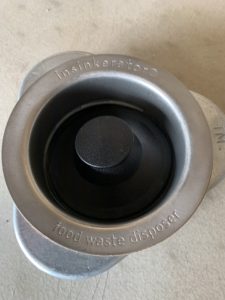This great article down below relating to The Handy Guide To Fixing Your Garbage Disposal Leaking is extremely stimulating. Don't miss out on it.

Waste disposal unit are crucial kitchen area home appliances that aid in throwing away food waste effectively. Nonetheless, a dripping waste disposal unit can be a discouraging and unpleasant trouble to take care of. Fortunately, numerous leakages can be taken care of easily with a couple of straightforward actions. In this write-up, we will certainly go over just how to fix a dripping garbage disposal effectively.
Introduction
Waste disposal unit are set up under cooking area sinks and are created to shred food waste right into smaller sized items, enabling it to travel through the plumbing system quickly. While these devices are typically reputable, leakages can take place over time because of wear and tear, loosened links, or damages to the unit.
Step-by-Step Guide to Dealing With a Leaking Garbage Disposal
Shut off the Power
Before attempting any repair work, ensure that the power to the garbage disposal unit is turned off to avoid the threat of electric shock.
Locate the Leakage
Determine the exact place of the leak and figure out the reason
Tighten Connections
Utilize a wrench to tighten up any kind of loose connections in between the disposal unit and the plumbing system.
Replace Seals or Gaskets
If the leak is because of worn seals or gaskets, eliminate the old parts and change them with brand-new ones.
Patching Cracks or Openings
For cracks or holes in the disposal system, usage epoxy or an ideal patching product to secure the broken area.
Identifying the Resource of the Leakage
Before attempting to take care of a leaking garbage disposal, it is vital to identify the source of the leak. This can generally be done via aesthetic evaluation or by carrying out straightforward tests.
Visual Examination
Examine the garbage disposal device very carefully for any indications of water leakage. Pay very close attention to locations around seals, gaskets, and link factors.
Testing for Leakages
One method to test for leakages is by running water with the disposal unit and looking for any type of noticeable signs of leak.
Common Reasons For Leaks in Waste Disposals
Worn Seals and Gaskets
Seals and gaskets play a critical role in protecting against water from dripping out of the garbage disposal. Over time, these parts can wear away, bring about leakages around the disposal unit.
Loose Links
The links between the garbage disposal and the plumbing system can end up being loose gradually, creating water to leak out throughout operation.
Cracks or Holes in the Disposal Unit
Physical damages to the garbage disposal, such as fractures or holes in the housing, can additionally lead to leakages.
Devices and Materials Needed for Taking Care Of a Dripping Garbage Disposal
Before beginning the repair service procedure, collect the necessary devices and products, consisting of a screwdriver, flexible wrench, plumber's putty, replacement seals or gaskets, and epoxy or patching material for repairing fractures or holes.
Testing the Waste Disposal Unit After Repair
As soon as the repair work is complete, examine the waste disposal unit by running water via it to guarantee that the leakage has been dealt with.
Preventive Upkeep Tips to Stay Clear Of Future Leaks
To avoid future leakages, it is important to carry out normal maintenance on your waste disposal unit. This includes keeping it tidy, staying clear of putting non-food products or tough objects down the disposal, and occasionally checking for leaks or various other issues.
Final thought
Finally, fixing a dripping waste disposal unit is a relatively straightforward process that can be completed with basic tools and materials. By following the steps described in this short article and practicing precautionary upkeep, you can maintain your waste disposal unit in good working problem and prevent expensive repair work in the future.
HERE’S HOW TO FIX YOUR GARBAGE DISPOSAL
WHAT TO DO IF SOMETHING IS STUCK IN YOUR GARBAGE DISPOSAL
If the impeller won’t turn, there’s probably something stuck in the disposal. It could be a steak bone or peach pit, although plumbers report pulling all sorts of inappropriate objects out of disposals, such as bottle caps or aluminum foil. Make sure power to the disposal is off, and look inside to see if you can see the source of the jam.
Never stick your fingers in a disposal. Pull out anything you see with tongs or pliers.
If the disposal still won’t work, it may be time to call a plumber or consider buying a new disposal. GEM Plumbing & Heating is here for all of your garbage disposal needs.
WHAT TO DO IF YOUR GARBAGE DISPOSAL DRAIN IS CLOGGED
Take everything out from underneath your sink and put a bucket or other container under your disposal to catch any water that drains out. Disconnect your disposal from the power supply. If it’s plugged into a wall outlet, unplug it. If it’s hardwired into an electrical box, go to the electrical panel and turn off the breaker for the disposal. Pour ¼ cup of baking soda into the drain, followed by ½ cup of white vinegar. Give the solution a few minutes to fizz and do its work. Look into the disposal with a flashlight to see if you can see an object that might be causing the clog. If you see it, remove it using tongs or pliers. MORE TIPS ON DEALING WITH A CLOGGED GARBAGE DISPOSAL
Never use drain cleaner in a garbage disposal. It can damage the plastic parts inside the disposal. You can also be splashed with the caustic liquid while working to clear the clog. Beware! Never stick your fingers into a garbage disposal. Trust us — not a good idea. In many instances, your dishwasher drains through your garbage disposal. This allows the disposal to grind any large food particles that may be drained out of your dishwasher. There are some jurisdictions, however, where the plumbing code prohibits such a connection. WHAT TO DO WHEN YOUR DISHWASHER DRAINS THROUGH THE DISPOSAL
Run some water in the sink so your plunger has at least a ½-inch of water to create a seal and plunge vigorously up and down several times. You may need to repeat this several times. Run hot water down the drain to clear any residue that remains.

We were made aware of that article about Why Is from a friend on another web property. Do you know someone else who is interested by Why Is ? Take a moment to share it. Thanks a bunch for your time. Kindly visit our site back soon.
Further Details